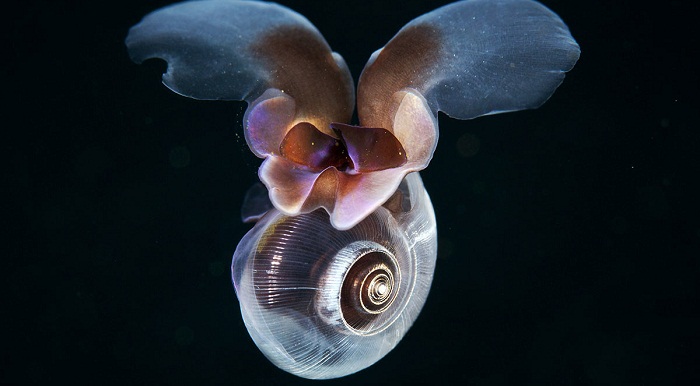Sea butterflies fly underwater just like insects do in air

The tiny snails, Limacina helicina, are found in the cold waters of the Arctic and Antarctic. Their heavy shell makes them sink like a rock when stationary – unless they secrete a mucous web that keeps them afloat.
They are also equipped with wing-like appendages that allow them to swim. But exactly how they beat their wings and how that allows them to move was unknown.
Now David Murphy at John Hopkins University in Baltimore and his team have captured the details of the winged motion in free-swimming sea snails for the first time (see video above).
They set up four high-speed cameras in a tank to focus on a cube of water about 2 centimetres long on each side. To track the water flow around the wings, they mixed tiny particles into the seawater and used two lasers to illuminate them.
They then let loose 20 sea snails in the tank – itself a feat given how fragile they are – and hoped some of them would “fly” in front of the camera.
Camera shy
On three occasions, one of them swam through the tiny volume. “We were lucky,” says Murphy, “they were right in the field of view.”
What they saw surprised them. Most zooplankton use their appendages as paddles to push them through the water, relying on drag to move.
But sea snails flap their wings just like a fruit fly, generating lift. “I had an ‘Aha!’ moment when I saw its wing tips move in the same distinct figure eight pattern,” says Murphy.
Even though gastropods and insects diverged from a common ancestor 550 million years ago, sea snails use the same clap-and-fling mechanism flies use, which involves bringing their wings together then quickly pushing them apart.
This shows evolutionary convergence on a similar locomotion technique to move through a similar environment. Due to their tiny size, the balance of inertial and viscous forces sea snails come across in water is similar to that experienced by flies in air.
Hydrodynamic advantage
Examining sea snail wing strokes could also help us better understand insect flight. Insects like fruit flies flap their wings so fast – 200 beats per second – it is hard to track the aerodynamics.
Sea snails are much slower, at about five beats per second. “We were able to see the vortices at the tips of the animal’s wings as it does this,” says Murphy.
One unique feature seen in sea snails was the pitch of its body. As it “flies” underwater, it pitches its body forwards and backwards a huge amount with each wing stroke, up to 60 degrees in each direction, whereas flying insects keep their bodies fairly still.
Murphy thinks this motion could help it position its wings in the water so it doesn’t have to move them as far on each stroke, giving it a hydrodynamic advantage.
Brad Gemmell at the University of South Florida, who studies the swimming techniques of marine animals, thinks that the unique propulsive mechanism could be incorporated into new designs of micro flying vehicles.
“Animals have had millions of years of selective pressure helping to test and design the best strategies and how to move through a fluid using comparatively little energy,” he says.















































